GRACE/GFO and Swarm Observation Analysis of the 2023–2024 Extreme Drought in the Amazon River Basin
Abstract
1. Introduction
2. Study Area
3. Data and Methods
3.1. Data
3.1.1. GRACE/GFO Data
3.1.2. Swarm Data
3.1.3. Global Precipitation Measurement (GPM) Data
3.1.4. ERA5-Land Data
3.1.5. Drought Index Data
3.1.6. Climate Index
3.1.7. ERA5 Data
3.2. Method
3.2.1. Improvement in TWSC Uncertainty
- 1.
- Uncertainty assessment of TWSC
- 2.
- TWSC fusion
3.2.2. GRACE-Based Drought Severity Index (GRACE-DSI)
3.2.3. Standardized Precipitation Index (SPI)
3.2.4. Nash–Sutcliffe (NSE) Efficiency Coefficient
3.2.5. Drought Characteristics
3.2.6. Migration of the Center of Gravity
3.2.7. Vertical Integrated Water Vapor Flux (VIWVF) and Water Vapor Flux Divergence
4. Results
4.1. Continuous TWSC Time Series Construction
4.2. Drought Process
4.3. Drought Propagation
4.4. Associated SST and Atmospheric Anomalies
5. Discussion
5.1. Connection Between Atmospheric Vertical Movement and El Niño
5.2. Impact of Human Activities
6. Conclusions
- (1)
- This extreme drought, ranked as the fourth-most severe in the ARB since 2003, exhibited a six-month duration with a drought peak of −1.29 and a drought severity index of −5.62. Initiating in the northwestern subregion, the drought propagated eastward and southward, eventually encompassing the entire basin. The eastern sector suffered the most pronounced impacts, characterized by the largest depletion of TWS.
- (2)
- Spatially, the 2023 drought’s footprint mirrored that of the 2015–2016 event, yet featured distinct temporal-severity metrics: it had the longest duration and highest severity in the basin’s eastern domain alongside the most significant water storage deficit in that region. While the 2015–2016 drought exhibited greater overall severity, both events recorded comparable peak drought indices: the former endured for 14 months, contrasting with the 2023 drought’s six-month duration.
- (3)
- The direct causes of the drought are reduced PRE and increased temperatures. However, this drought is closely linked to the El Niño event that occurred in June 2023. The El Niño event led to an abnormal intensification of atmospheric descending movements in the ARB by altering the Walker circulation, thereby resulting in reduced PRE and rising temperatures. Additionally, extensive deforestation of the Amazon rainforest due to human activities has also contributed to and exacerbated drought severity.
Author Contributions
Funding
Data Availability Statement
Acknowledgments
Conflicts of Interest
Abbreviations
| ARB | Amazon River Basin |
| PRE | precipitation |
| TWS | terrestrial water storage |
| SM | soil moisture |
| TWSC | terrestrial water storage change |
| GRACE | Gravity Recovery and Climate Experiment |
| GFO | GRACE Follow-On |
| WSD | water storage deficit |
| ENSO | El Niño–Southern Oscillation |
| SH | spherical harmonic |
| CSR | Center for Space Research at the University of Texas at Austin |
| GFZ | Helmholtz Centre Potsdam—German Research Centre for Geosciences |
| JPL | Jet Propulsion Laboratory |
| GPM | global precipitation measurement |
| ET | evapotranspiration |
| SPEI | standardized precipitation evapotranspiration index |
| SCPDSI | self-calibrating palmer drought severity index |
| SST | sea surface temperature |
| NOAA | National Oceanic and Atmospheric Administration |
| NCEP–DOE | National Centers for Environment Prediction–Department of Energy |
| GRACE-DSI | GRACE-based drought severity index |
| DAR | drought area ratio |
| CC | correlation coefficient |
| NSE | Nash–Sutcliffe efficiency coefficient |
| SEWC | south equatorial warm current |
| SHPS | subtropical high pressure system |
| GLDAS | Global Land Data Assimilation System |
| VIWVF | vertical integrated water vapor flux |
Appendix A
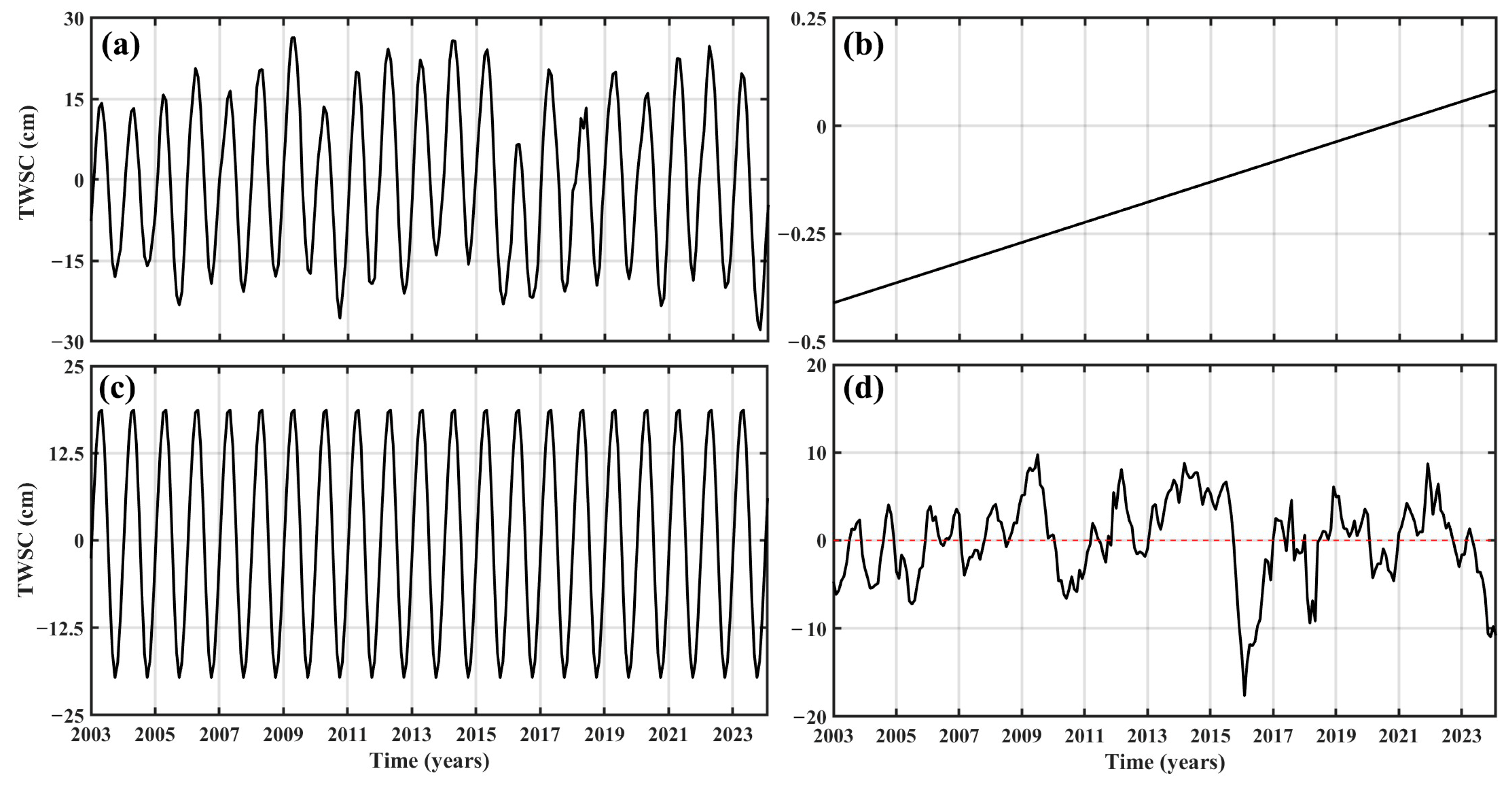
References
- Chris, F. Ethiopia, Somalia and Kenya face devastating drought. Nature 2020, 586, 645–646. [Google Scholar] [CrossRef]
- Dai, A. Drought under global warming: A review. WIREs Clim. Change 2011, 2, 45–65. [Google Scholar] [CrossRef]
- Cui, L.; Zhang, C.; Yao, C.; Luo, Z.; Wang, X.; Li, Q. Analysis of the influencing factors of drought events based on GRACE data under different climatic conditions: A case study in Mainland China. Water 2021, 13, 2575. [Google Scholar] [CrossRef]
- Climate Change Made 2023 Amazon Drought 30 Times More Likely, Scientist Say. Available online: https://news.mongabay.com/2024/01/climate-change-made-2023-amazon-drought-30-times-more-likely-scientists-say/ (accessed on 8 June 2025).
- Record Temperatures and Heatwaves Bring Unprecedented Drought to the Amazon Basin. Available online: https://joint-research-centre.ec.europa.eu/jrc-news-and-updates/record-temperatures-and-heatwaves-bring-unprecedented-drought-amazon-basin-2023-12-20_en (accessed on 8 June 2025).
- Amazons. Record Drought Driven by Climate Change. Available online: https://www.bbc.com/news/science-environment-68032361 (accessed on 11 June 2025).
- Drought Parches the Central Amazon in October 2023. Available online: https://www.climate.gov/news-features/event-tracker/drought-parches-central-amazon-october-2023 (accessed on 11 June 2025).
- Espinoza, J.; Jimenez, J.; Marengo, J.; Schongart, J.; Ronchail, J.; Lavado-Casimiro, W.; Ribeiro, J. The new record of drought and warmth in the Amazon in 2023 related to regional and global climatic features. Sci. Rep. 2024, 14, 8107. [Google Scholar] [CrossRef] [PubMed]
- Gouweleew, B.; Kvas, A.; Gruber, G.; Gain, A.; Mayer-Gürr, T.; Flechtner, F.; Güntner, A. Daily GRACE Field solutions track major flood events in the Ganges-Brahmaputra Delata. Hydrol. Earth Syst. Sci. 2018, 22, 2867–2880. [Google Scholar] [CrossRef]
- Scanlon, B.; Zhang, Z.; Save, H.; Sun, A.; Schrnied, H.; van Beek, L.; Wiese, D.; Wada, Y.; Long, D.; Reedy, R.; et al. Global models underestimate large decadal declining and rising water storage trends relative to GRACE satellite data. Proc. Natl. Acad. Sci. USA 2018, 115, E1080–E1089. [Google Scholar] [CrossRef]
- Mu, Q.; Zhao, M.; Running, S. Improvements to a MODIS global terrestrial evapotranspiration algorithm. Remote Sens. Environ. 2011, 115, 1781–1800. [Google Scholar] [CrossRef]
- Chawla, I.; Karthikeyan, L.; Mishra, A. A review of remote sensing applications for water security: Quantity, quality, and extremes. J. Hydrol. 2020, 585, 124826. [Google Scholar] [CrossRef]
- Reager, J.; Thomas, B.; Famiglitti, J. River basin flood potential inferred using GRACE gravity observations at several months lead time. Nat. Geosci. 2014, 7, 588–592. [Google Scholar] [CrossRef]
- Tapley, B.; Watkins, M.; Flechtner, F.; Reigber, C.; Bettadpur, S.; Rodell, M.; Sasgen, I.; Famiglietti, J.; Landerer, F.; Chambers, D.; et al. Contributions of GRACE to understanding climate change. Nat. Clim. Change 2019, 9, 358–369. [Google Scholar] [CrossRef]
- Cui, L.; Meng, J.; Li, Y.; An, J.; Zou, Z.; Zhong, L.; Mao, Y.; Wu, G. Spatiotemporal evolution characteristics of 2022 Pakistan severe flood event based on multi-source satellite gravity observations. Remote Sens. 2024, 16, 1601. [Google Scholar] [CrossRef]
- Chen, J.; Wilson, C.; Tapley, B.; Yang, Z.; Niu, G. 2005 drought event in the Amazon River basin as measured by GRACE and estimated by climate models. J. Geophys. Resear. Solid Earth 2009, 114, B05404. [Google Scholar] [CrossRef]
- Thomas, A.; Reager, J.; Famiglietti, J.; Rodell, M. A GRACE-based water storage deficit approach for hydrological drought characterization. Geophys. Resear. Lett. 2014, 41, 1537–1545. [Google Scholar] [CrossRef]
- Nie, N.; Zhang, W.; Guo, H.; Ishwaran, N. 2010-2012 drought and flood events in the Amazon basin inferred by GRACE satellite observations. J. Appl. Remote Sens. 2015, 9, 096023. [Google Scholar] [CrossRef]
- Panisset, J.; Libonati, R.; Gouveia, C.; Machado-Silva, F.; França, D.; França, J.; Peres, L. Contrasting patterns of the extreme drought episodes of 2005, 2010 and 2015 in the Amazon basin. Int. J. Climatol. 2018, 38, 1096–1104. [Google Scholar] [CrossRef]
- Da Encarnação, T.; Arnold, D.; Bezděk, A.; Dahle, C.; Doornbos, E.; van den IJssel, J.; Jäggi, A.; Mayer-Gürr, T.; Sebera, J.; Visser, P.; et al. Gravity field models derived from Swarm GPS data. Earth Planets Space 2016, 68, 127. [Google Scholar] [CrossRef]
- Zangerl, F.; Griesaucr, F.; Sust, M.; Montenbruck, O.; Buckert, B.; Garcia, A. SWARM GPS Precise Orbit Determination Receiver Initial In-Orbit Performance Evaluation. In Proceedings of the 27th International Technical Meeting of the Satellite Division of the Institute of Navigation, Tampa, FL, USA, 8–12 September 2014; pp. 1459–1468. [Google Scholar]
- Teixeira da Encarnação, J.; Visser, P.; Arnold, D.; Bezdek, A.; Doornbos, E.; Ellmer, M.; Guo, J.; van den IJssel, J.; Iorfida, E.; Jäggi, A.; et al. Description of the multi-approach gravity field models from Swarm GPS data. Earth Syst. Sci. Data 2020, 12, 1385–1417. [Google Scholar] [CrossRef]
- Bezdĕk, A.; Sebera, J.; Teixeira da Encarnação, J.; Klokocnik, J. Time-variable gravity fields derived from GPS tracking of Swarm. Geophys. J. Int. 2016, 205, 1665–1669. [Google Scholar] [CrossRef]
- Jäggi, A.; Dahle, C.; Arnold, D.; Bock, H.; Meyer, U.; Beutler, G.; van den Ijssel, J. Swarm kinematic orbits and gravity fields from 18 months of GPS data. Adv. Space Res. 2016, 57, 218–233. [Google Scholar] [CrossRef]
- Lück, C.; Kusche, J.; Rietbroek, R.; Löcher, A. Time-variable gravity fields and ocean mass change from 37 months of kinematic Swarm orbits. Solid Earth 2018, 9, 323–339. [Google Scholar] [CrossRef]
- Cui, L.; Meng, J.; Zhong, B.; An, J.; Li, Y.; Guo, H.; Lu, Y. Spatiotemporal evolution of 1998 extreme flood event in the Yangtze River basin from the perspective of the reconstructed GRACE/GRACE-FO data. J. Hydrol. Regional Studies 2025, 60, 102551. [Google Scholar] [CrossRef]
- Cui, L.; Song, Z.; Luo, Z.; Zhong, B.; Wang, X.; Zou, Z. Comparison of terrestrial water storage changes derived from GRACE/GRACE-FO and Swarm: A case in the Amazon River basin. Water 2020, 12, 3128. [Google Scholar] [CrossRef]
- Li, F.; Wang, Z.; Chao, N.; Feng, J.; Zhang, B.; Tian, K. 2015–2016 drought event in the Amazon River basin as measured by Swarm constellation. Geomat. Inf. Sci. Wuhan Univ. 2020, 45, 595–603. (In Chinese) [Google Scholar]
- Cui, L.; Yin, M.; Huang, Z.; Yao, C.; Wang, X.; Lin, X. The drought events over the Amazon River basin from 2003 to 2020 detected by GRACE/GRACE and Swarm satellites. Remote Sens. 2020, 14, 2887. [Google Scholar] [CrossRef]
- Yuan, D.; Lu, E. Severe drought in Northeast China during summer 2014: Anomalies in atmospheric circulation and humidity. Int. J. Climatol. 2020, 42, 7532–7544. [Google Scholar]
- Cui, L.; Zhong, L.; Meng, J.; An, J.; Zhang, C.; Li, Y. Spatiotemporal evolution features of the 2022 compound hot and drought event over the Yangtze River basin. Remote Sens. 2024, 16, 1367. [Google Scholar] [CrossRef]
- Duffy, P.; Brando, P.; Asner, G.; Field, C.; Christopher, B. Projections of future meteorological drought and wet periods in the Amazon. Proc. Natl. Acad. Sci. USA 2015, 112, 13172–13177. [Google Scholar] [CrossRef] [PubMed]
- Papastefanon, P.; Zang, C.; Angelov, Z.; de Castro, A.; Jimenez, J.; de Rezande, L.; Ruscica, R.; Sakschewski, B.; Sörensson, A.; Thonicke, K.; et al. Recent extreme drought events in the Amazon rainforest: Assessment of different precipitation and evapotranspiration datasets and drought indicators. Bioeosciences 2022, 19, 3843–3861. [Google Scholar]
- Cheng, M.; Tapley, B. Variances in the Earth’s oblateness during the past 28 years. J. Geophys. Resear. Solid Earth 2004, 109, B09402. [Google Scholar]
- Swenson, S.; Chambers, D.; Whar, J. Estimating geocenter variations from a combination of GRACE and ocean model input. J. Geophys. Resear. Solid Earth 2008, 113, B08410. [Google Scholar]
- Landerer, F.; Swenson, S. Accuracy of scaled GRACE terrestrial water storage estimates. Water Resour. Resear. 2012, 48, W04531. [Google Scholar] [CrossRef]
- Jean, Y.; Meyer, U.; Jäggi, A. Combination of GRACE monthly gravity field solutions from different processing strategies. J. Geod. 2018, 92, 1313–1328. [Google Scholar] [CrossRef]
- Huffman, G.; Stocker, E.; Bolvin, D.; Nelkin, E.; Tan, J. GPM IMERG Final Precipitation L3 1 Day 0.1 Degree × 0.1 Degree V06; Savtchenko, A., Ed.; Goddard Earth Sciences Data and Information Services Center (GES DISC): Greenbelt, MD, USA, 2019. [Google Scholar]
- Muñoz-Sabater, J.; Dutra, E.; Agusti-Panareda, A.; Albergel, C.; Arduini, G.; Balsamo, G.; Boussetta, S.; Choulga, M.; Harrigan, S.; Hersbach, H.; et al. ERA-land: A state-of-the-art global reanalysis dataset for land applications. Earth Syst. Sci. Data 2021, 13, 4349–4383. [Google Scholar] [CrossRef]
- Tegos, A.; Stefanidis, S.; Cody, J.; Koutsoyiannis, D. On the Sensitivity of Standardized-Precipitation-Evapotranspiration and Aridity Indexes Using Alternative Potential Evapotranspiration Models. Hydrology 2023, 10, 64. [Google Scholar] [CrossRef]
- Dai, A.; Trenberth, K.; Qian, T. A global dataset of Palmer Drought Severity Index for 1870–2002: Relationship with soil moisture and effects of surface warming. J. Hydrometeorol. 2004, 5, 1117–1130. [Google Scholar] [CrossRef]
- Wells, N.; Goddard, S.; Hayes, M. A self-calibrating palmer drought severity index. J. Clim. 2004, 17, 2335–2351. [Google Scholar] [CrossRef]
- Wang, L.; Huang, G.; Chen, W.; Wang, T. Super drought under global warming: Concept, monitoring index and validation. Bull. Am. Meteorol. Soc. 2023, 104, E943–E969. [Google Scholar] [CrossRef]
- Trenberth, K. The definition of El Niño. Bull. Amer. Meteorol. Soc. 1997, 78, 2771–2777. [Google Scholar] [CrossRef]
- L’Heureux, M.; Thompson, D. Observed relationships between the El Niño-Southern Oscillation and the extratropical zonal-mean circulation. J. Clim. 2006, 19, 276–287. [Google Scholar] [CrossRef]
- Sakumura, C.; Bettadpur, S.; Bruinsma, S. Comparison of GRACE gravity field models. Geophys. Res. Lett. 2014, 41, 2638–2645. [Google Scholar]
- Long, D.; Pan, Y.; Zhou, J.; Chen, Y.; Hou, X.; Hong, Y.; Scanlon, B.; Longuevergne, L. Global analysis of spatiotemporal variability in merged total water storage changes using multiple GRACE products and global hydrological models. Remote Sens. Environ. 2017, 192, 198–216. [Google Scholar] [CrossRef]
- Cui, L.; Luo, C.; Yao, C.; Zou, Z.; Wu, G.; Li, Q.; Wang, X. The influence of climate change on forest fires in Yunnan province, Southwest China detected by GRACE satellites. Remote Sens. 2022, 14, 712. [Google Scholar] [CrossRef]
- Lu, J.; Jia, L.; Zhou, J. Quantification and assessment of global terrestrial water storage deficit caused by drought using GRACE satellite data. IEEE J. Sel. Top. Appl. Earth Obs. Remote Sens. 2022, 15, 5001–5012. [Google Scholar] [CrossRef]
- Cleveland, R.; Cleveland, W.; Terpenning, I. STL: A seasonal-trend decomposition procedure based on loess. J. Off. Stat. 1990, 6, 3–73. [Google Scholar]
- Duan, A.; Zhong, Y.; Xu, G.; Yang, K.; Tian, B.; Wu, Y.; Bai, H.; Hu, E. Quantifying the 2022 extreme drought in the Yangtze River basin using GRACE-FO. J. Hydrol. 2024, 630, 130680. [Google Scholar] [CrossRef]
- Zhao, M.; Geruo, A.; Velicogna, I.; Kimball, J. A global gridded dataset of GRACE drought severity index for 2002-14: Comparison with PDSI and SPEI and a case study of the Australia millennium drought. J. Hydrometeorol. 2017, 18, 2117–2129. [Google Scholar] [CrossRef]
- Vicente-Serrano, S. Differences in spatial patterns of drought on different time scales: An analysis of the Iberian Peninsula. Water Resour. Manag. 2006, 20, 37–60. [Google Scholar] [CrossRef]
- Liu, Y.; Hu, K.; Huang, G. Effect of the Tropical Sea Surface Temperature on the Interannual Rainfall Variability and Its Mechanism over the Amazon in the Dry Season. Clim. Environ. Res. 2020, 27, 263–275. (In Chinese) [Google Scholar]
- Chen, Z.; Li, J.; Xiang, B.; Duan, Q.; Li, S.; Wang, S. Spatiotemporal variation of drought in Yunnan province calculated using the standardized precipitation index. J. Irrig. Drain. 2023, 42, 92–99. (In Chinese) [Google Scholar]
- Cui, L.; Chen, X.; An, J.; Yao, C.; Su, Y.; Zhu, C.; Li, Y. Spatiotemporal variation characteristics of drought and their connection to climate variability and human activity in the Pearl River basin, South China. Water 2023, 15, 1720. [Google Scholar] [CrossRef]
- Li, P.; Hu, Z.; Liu, Y. Shift in the trend of browning in Southwestern Tibetan Plateau in the past two decades. Agric. For. Meteorol. 2020, 287, 107950. [Google Scholar] [CrossRef]
- Ren, H.; Li, A.; Xie, P.; Hu, Z.; Xu, J.; Huang, Y.; Li, X.; Zhong, H.; Tian, X.; Ren, B.; et al. Estimation of the Precipitable Water and Water Vapor Fluxes in the Coastal and Inland Cities of China Using MAX-DOAS. Remote Sens. 2021, 13, 1675. [Google Scholar] [CrossRef]
- Ma, S.; Cao, J.; Zhao, H.; Zhou, X.; Ran, L. Decomposition of water vapor flux divergence and its application to a blizzard event over Ili Valley in Central Asia during 30 Nov to 1 Dec 2018. Atmos. Res. 2022, 270, 106079. [Google Scholar] [CrossRef]
- Syed, T.; Tajdar, H.; Famigglietti, M.R.; Chen, J.; Wilson, C. Analysis of terrestrial water storage changes from GRACE and GLDAS. Water Resour. Res. 2008, 44, WR005779. [Google Scholar] [CrossRef]
- Frapppart, F.; Papa, F.; da Silva, S.; Ramillien, G.; Prigent, C.; Seyler, S. Surface freshwater storage and dynamics in the Amazon basin during the 2005 exceptional drought. Environ. Res. Lett. 2021, 7, 044010. [Google Scholar] [CrossRef]
- Woodwell Climate Research Center (WCRC). Amazon Deforestation and Fire Update: November 2020. Available online: https://www.woodwellclimate.org/2020-amazondeforestation-and-fire-outlook-november (accessed on 25 July 2025).
- Jimenez, J.; Mattar, C.; Baichivich, J.; Santamaria-Artigas, A.; Takahashi, K.; Malhi, Y.; Sobrino, J.; Schrier, G. Record-breaking warming and extreme drought in the Amazon rainforest during the course of El Niño 2015–2016. Sci. Rep. 2016, 6, 33130. [Google Scholar] [CrossRef] [PubMed]
- De Brito, M.R.; Wahnfried, I. Groundwater dynamics and hydrogeological processes in the Alter do Chao Aquifer: A case study in Manaus, Amazonas—Brazil. Groundw. Sustain. Dev. 2025, 29, 101441. [Google Scholar] [CrossRef]
- Matsui, T.; Hernandez-Deckers, D.; Glangrande, S.; Biscaro, T.; Fridlind, A. A thermal-driven graupel generation process to explain dry-season convective vigor over the Amazon. Atmos. Chem. Phys. 2024, 24, 10793–10814. [Google Scholar] [CrossRef]
- Agudelo, J.; Arias, P.; Vieira, S.; Martinez, J. Influence of longer dry seasons in the Southern Amazon on patterns of water vapor transport over northern South America and the Caribbean. Clim. Dyn. 2018, 52, 2647–2665. [Google Scholar] [CrossRef]
- Ferreira, L.; Marotta, G.; Madden, E.; Horbe, A.; Santos, R.; Costa, J. Vertical displacement caused by hydrological influence in the Amazon Basin. J. Geophys. Res. Solid Earth 2021, 126, e2020JB020691. [Google Scholar] [CrossRef]
- Li, L.; Schmitt, R.; Ummenhofer, C.; Karnauskas, K. North Atlantic salinity as a predictor of Sahal rainfall. Sci. Adv. 2016, 2, e1501588. [Google Scholar] [CrossRef] [PubMed]
- Kebede, T.; Kebede, A.; Ayele, K. Identification of Water Vapor Flux Convergence Layers and Estimation of Precipitation over Ethiopia. Res. Sq. 2023, 10, 21203. [Google Scholar]
- Marengo, J.; Cunha, A.; Espinoza, J.; Fu, R.; Schongart, J.; Jimenez, J.; Costa, M.; Ribeiro, J.; Wongchuig, S.; Zhao, S. The drought of Amazonia in 2023–2024. Amer. J. Clim. Change 2024, 13, 26. [Google Scholar] [CrossRef]
- Wang, R.; He, J.; Luo, J.; Chen, L. Atlantic Warming Enhances the Influence of Atlantic Niño on ENSO. Geophys. Res. Lett. 2024, 51, e2023GL108013. [Google Scholar] [CrossRef]
- Posada-Marin, J.; Arias, P.; Jaramillo, F.; Salazar, J. Global Impacts of El Niño on Terrestrial Moisture Recycling. Geophys. Res. Lett. 2023, 50, e2023GL103147. [Google Scholar] [CrossRef]
- Ferrante, L.; Fearnside, P. The Amazons Road to deforestation. Science 2020, 369, 634. [Google Scholar] [CrossRef] [PubMed]
- Deforestation in the Amazon: Past, Present and Future. Available online: https://infoamazonia.org/en/2023/03/21/deforestation-in-the-amazon-past-present-and-future/nino-main-driver-of-exceptional-drought-in-highly-vulnerable-amazon-river-basin/ (accessed on 11 June 2025).

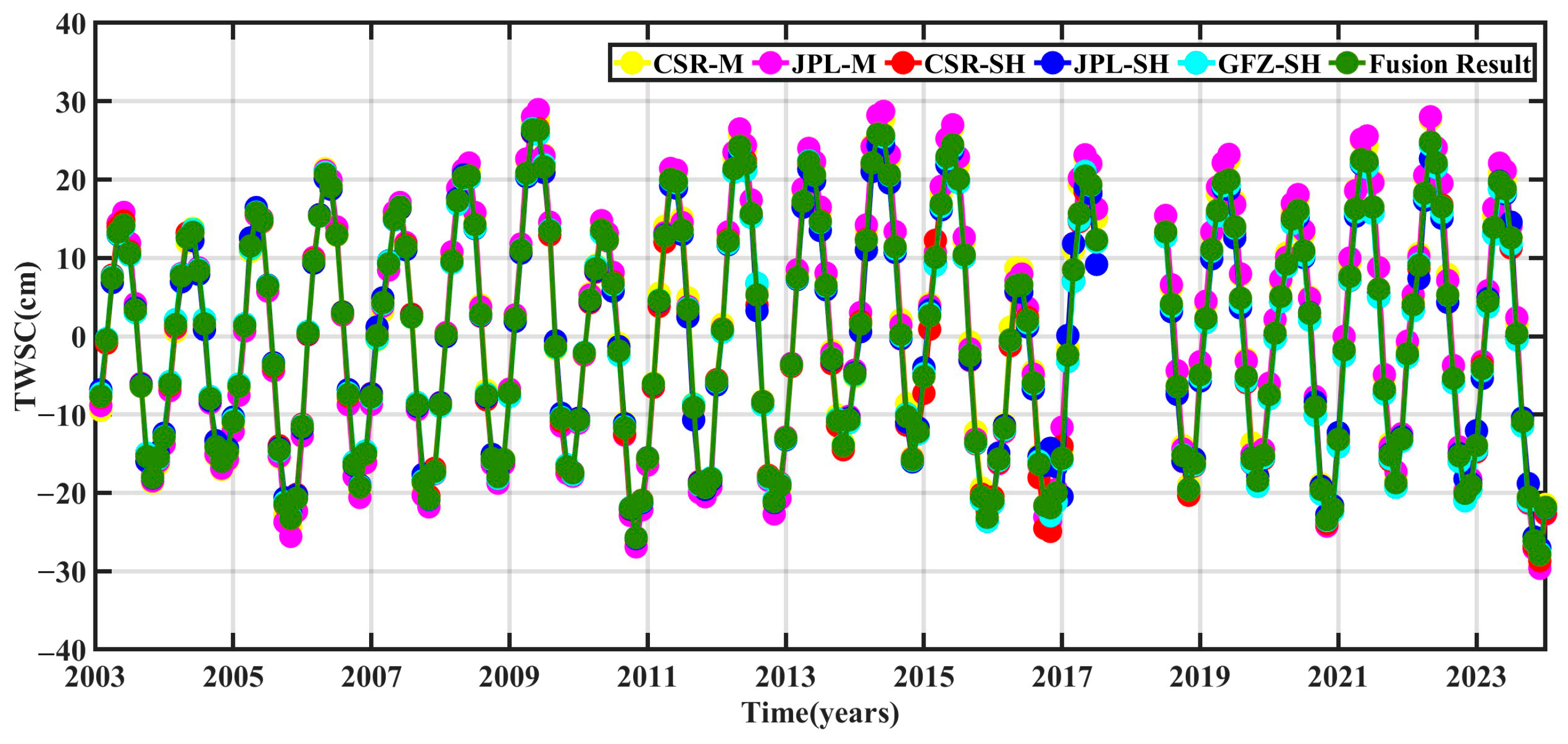
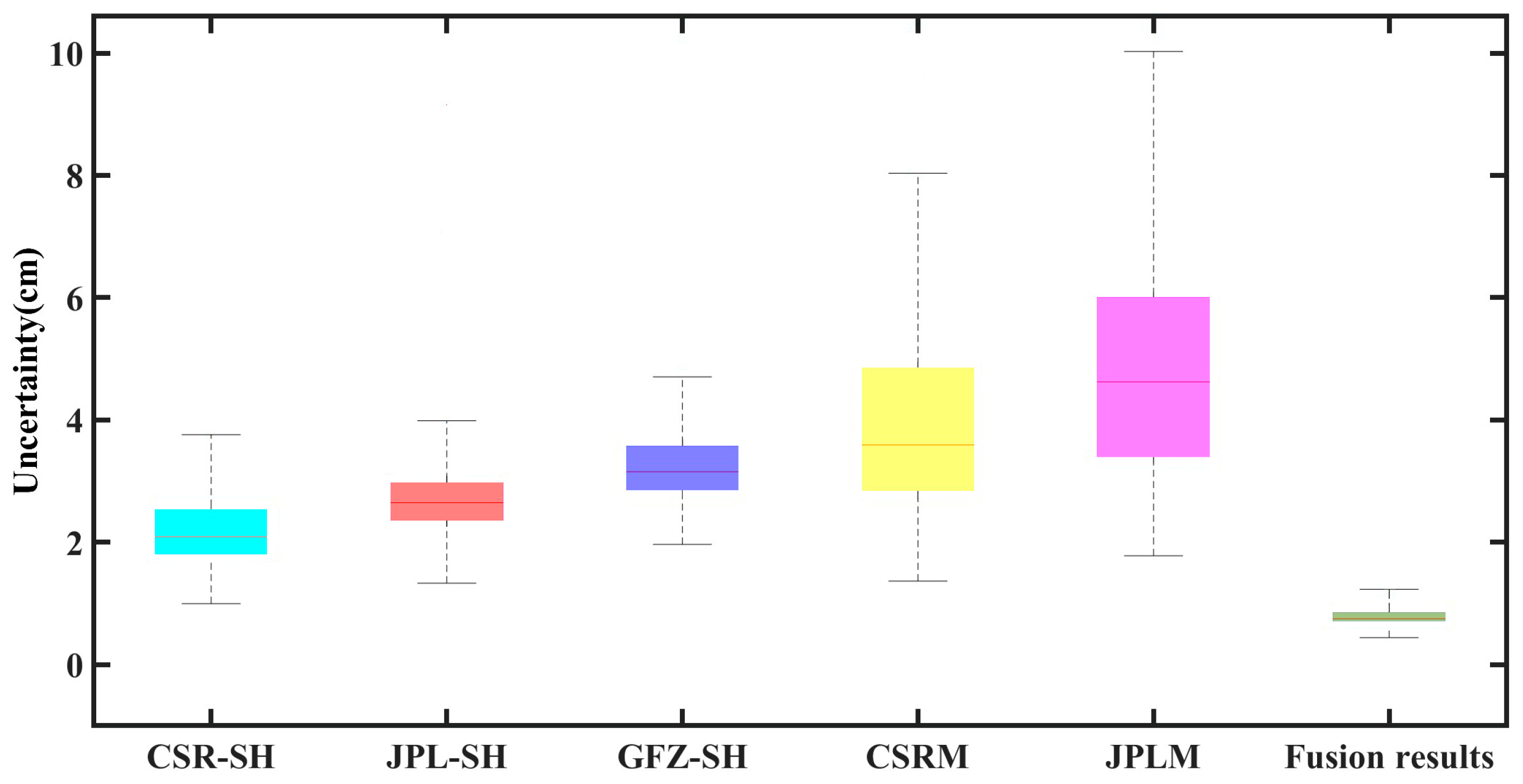

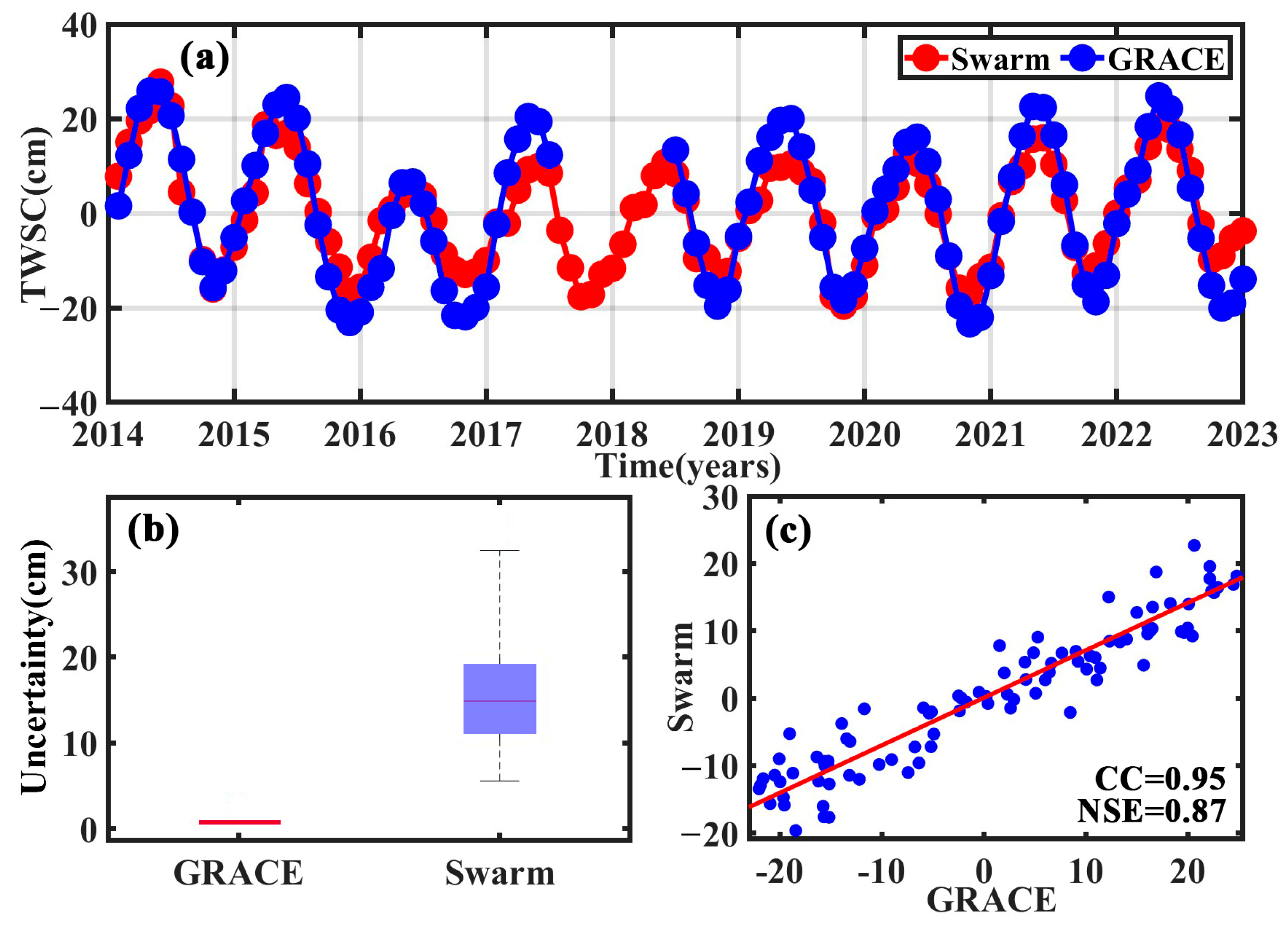

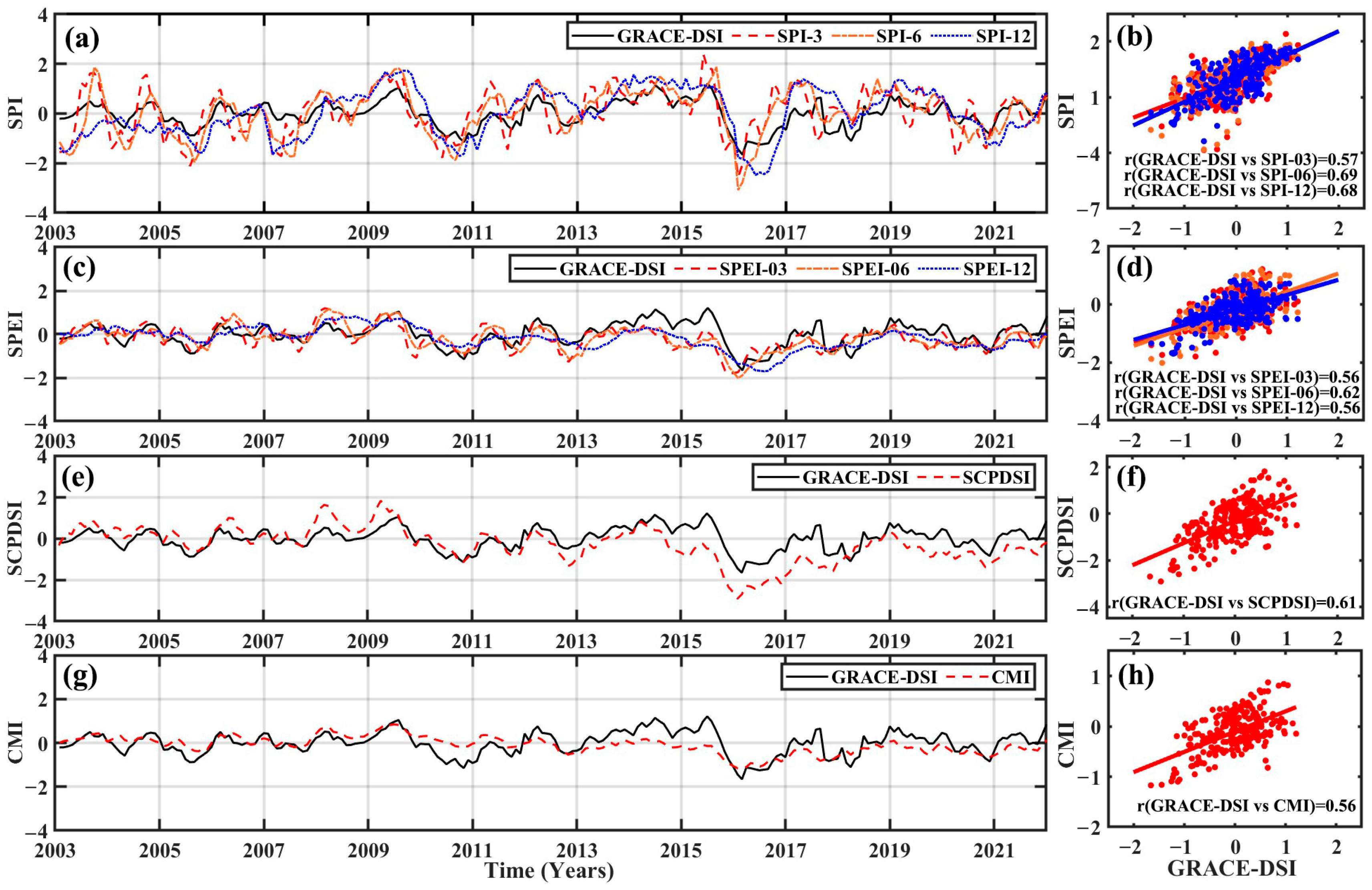
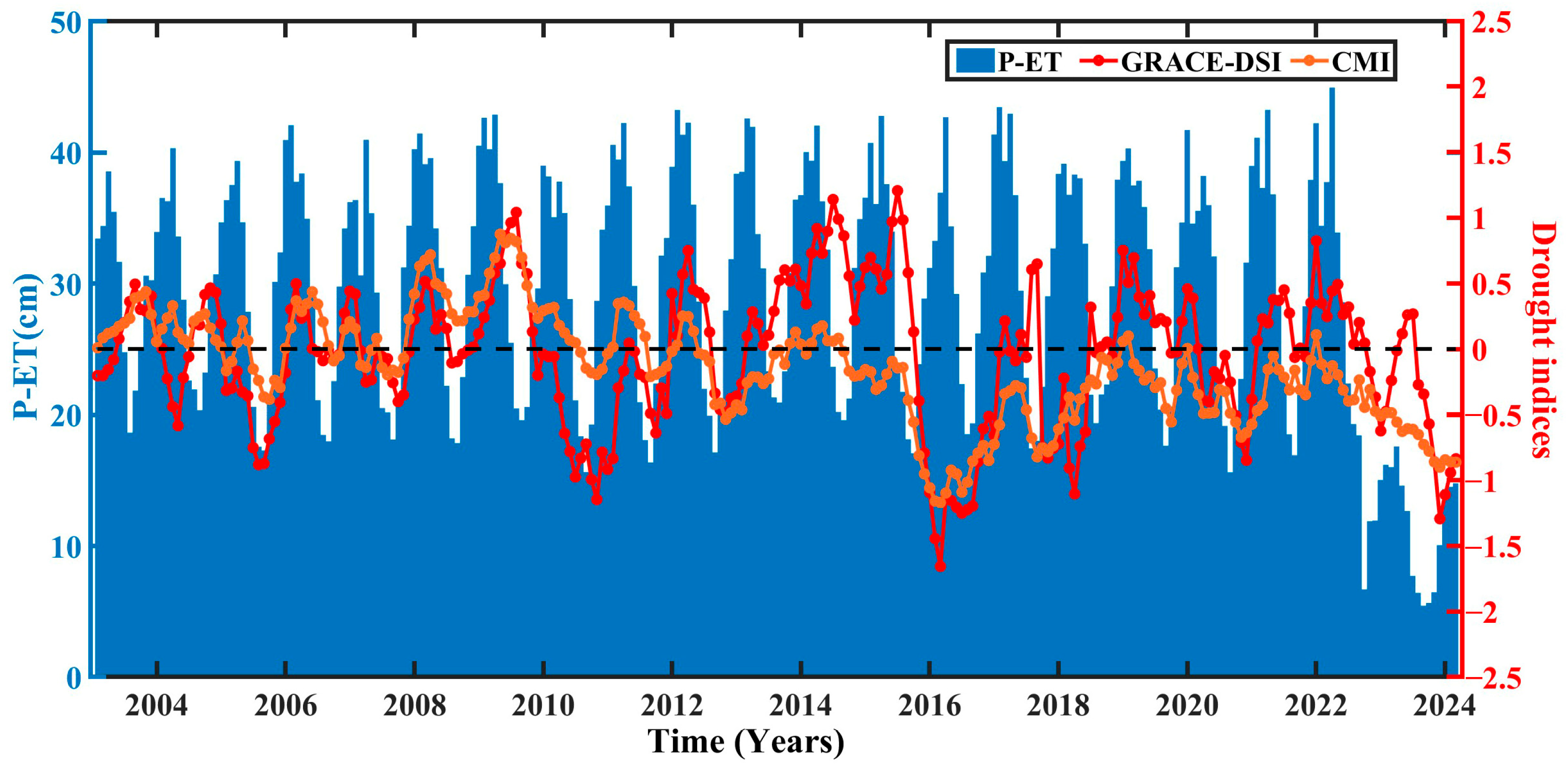
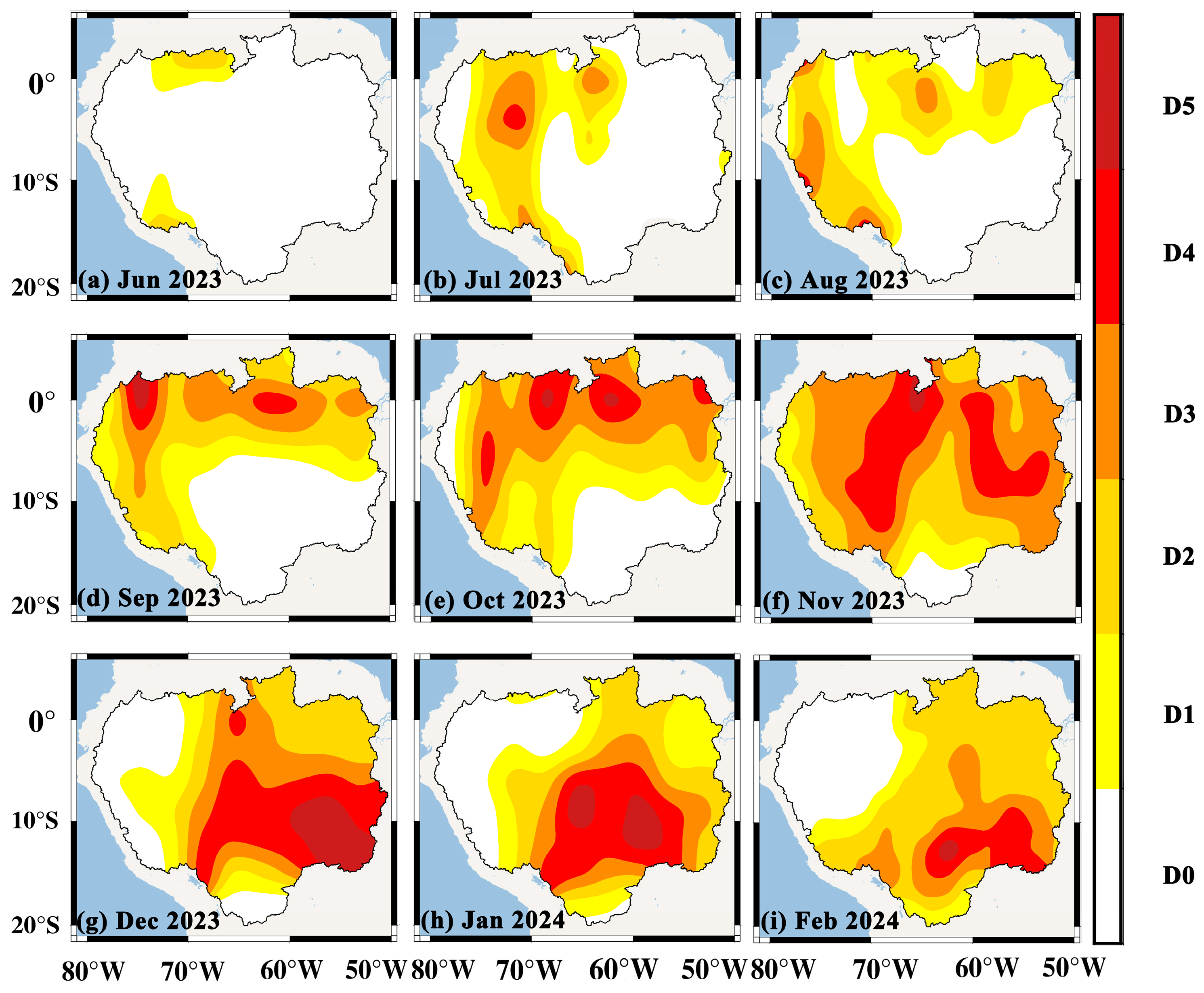
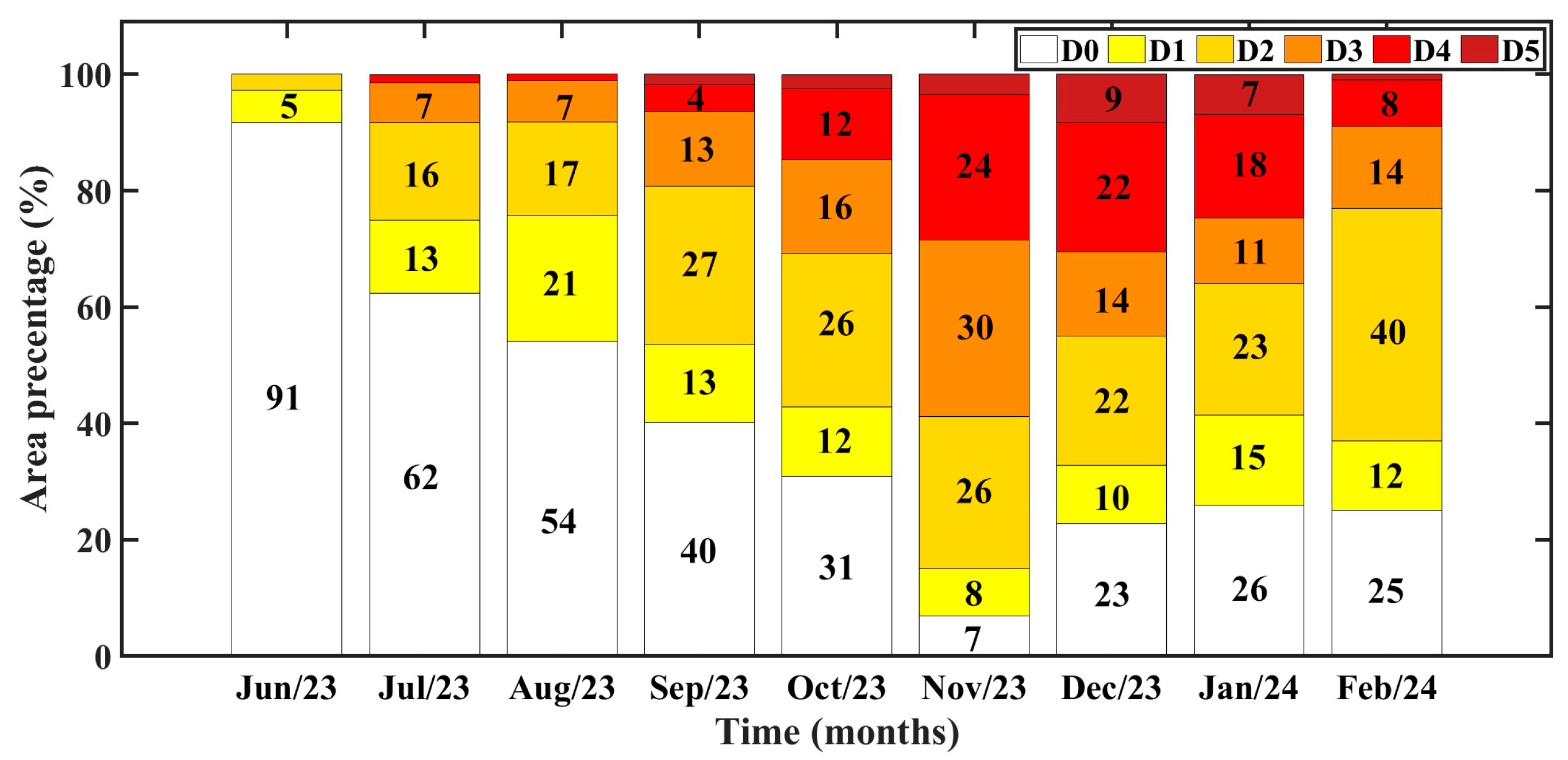
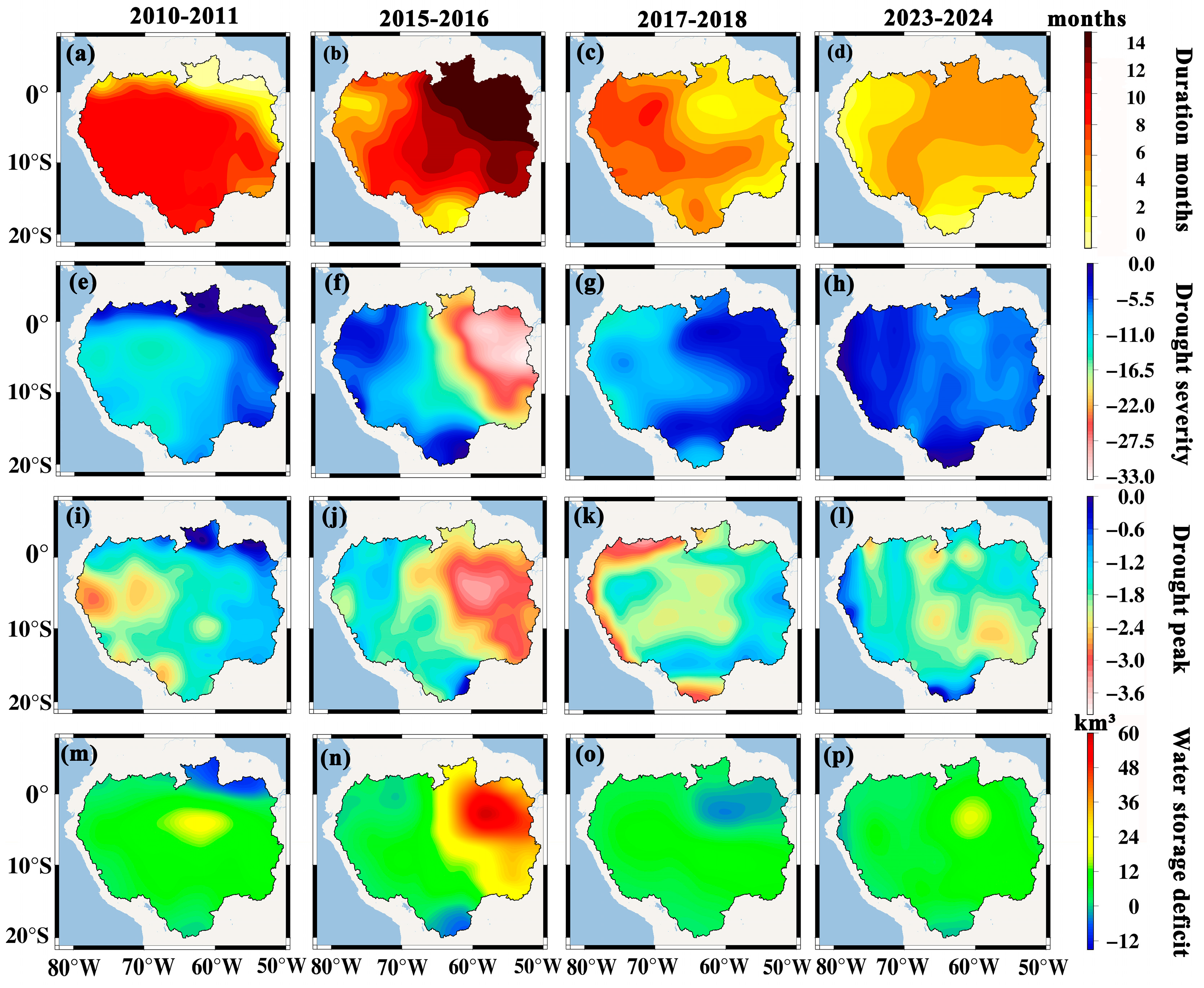
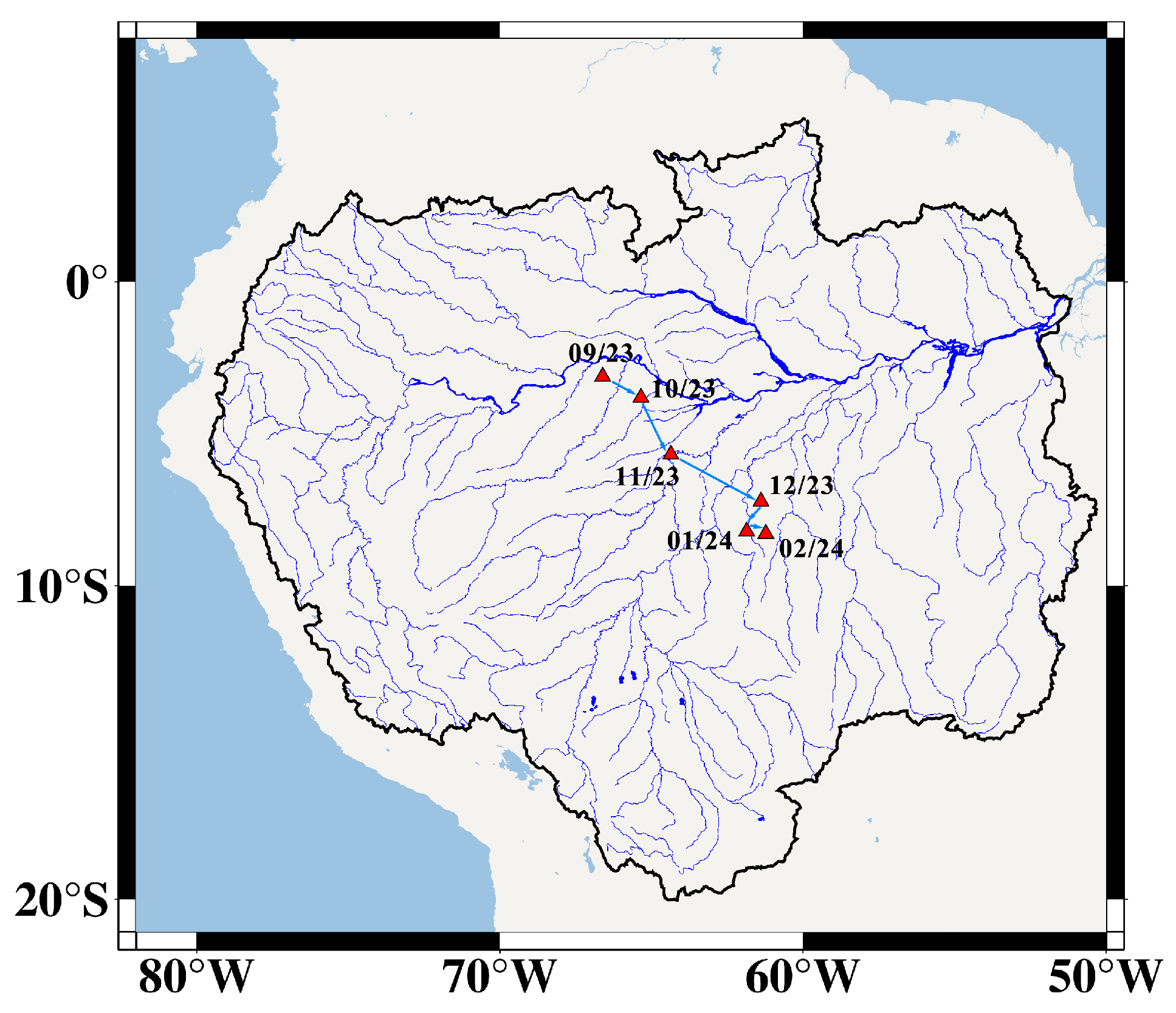
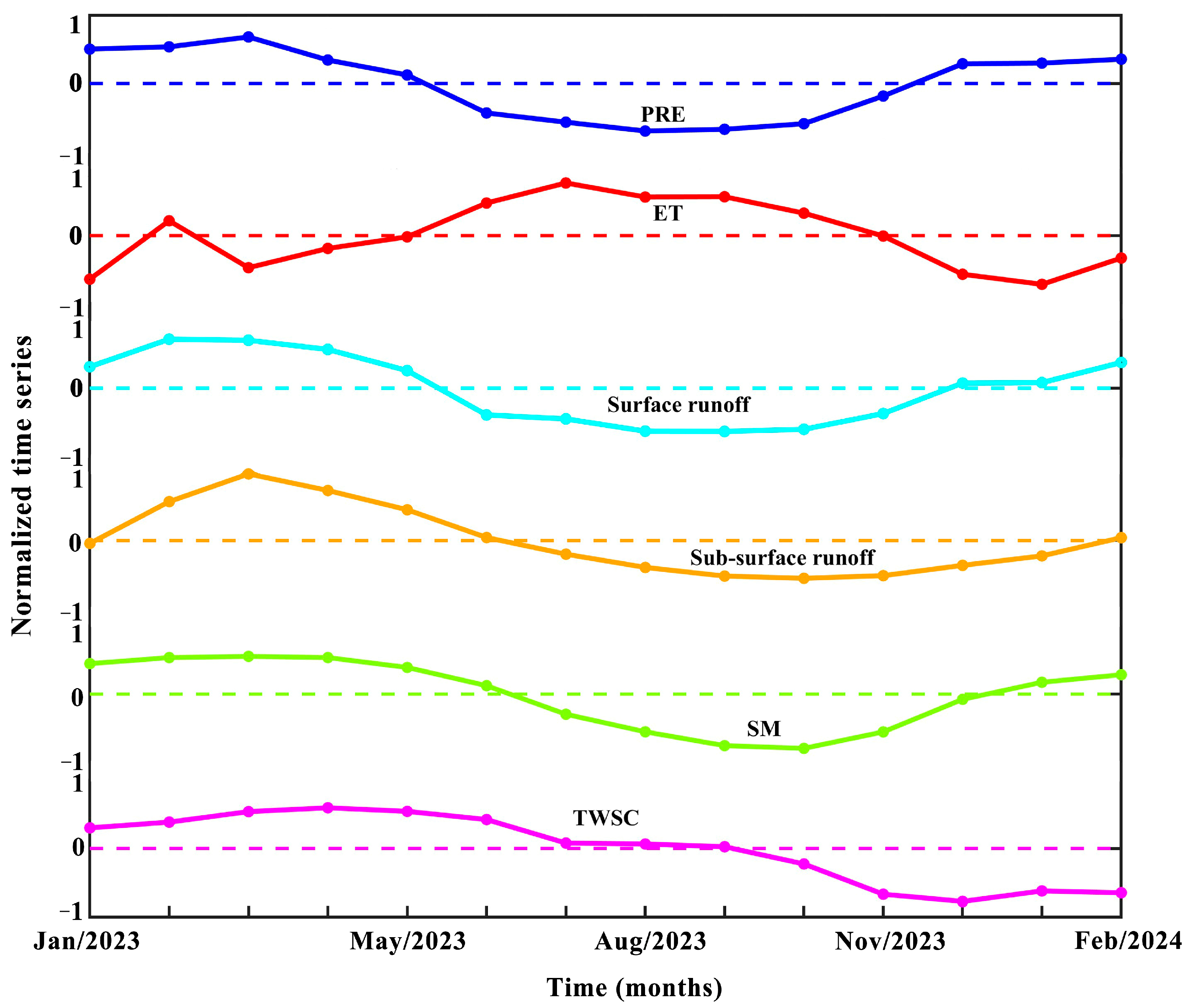
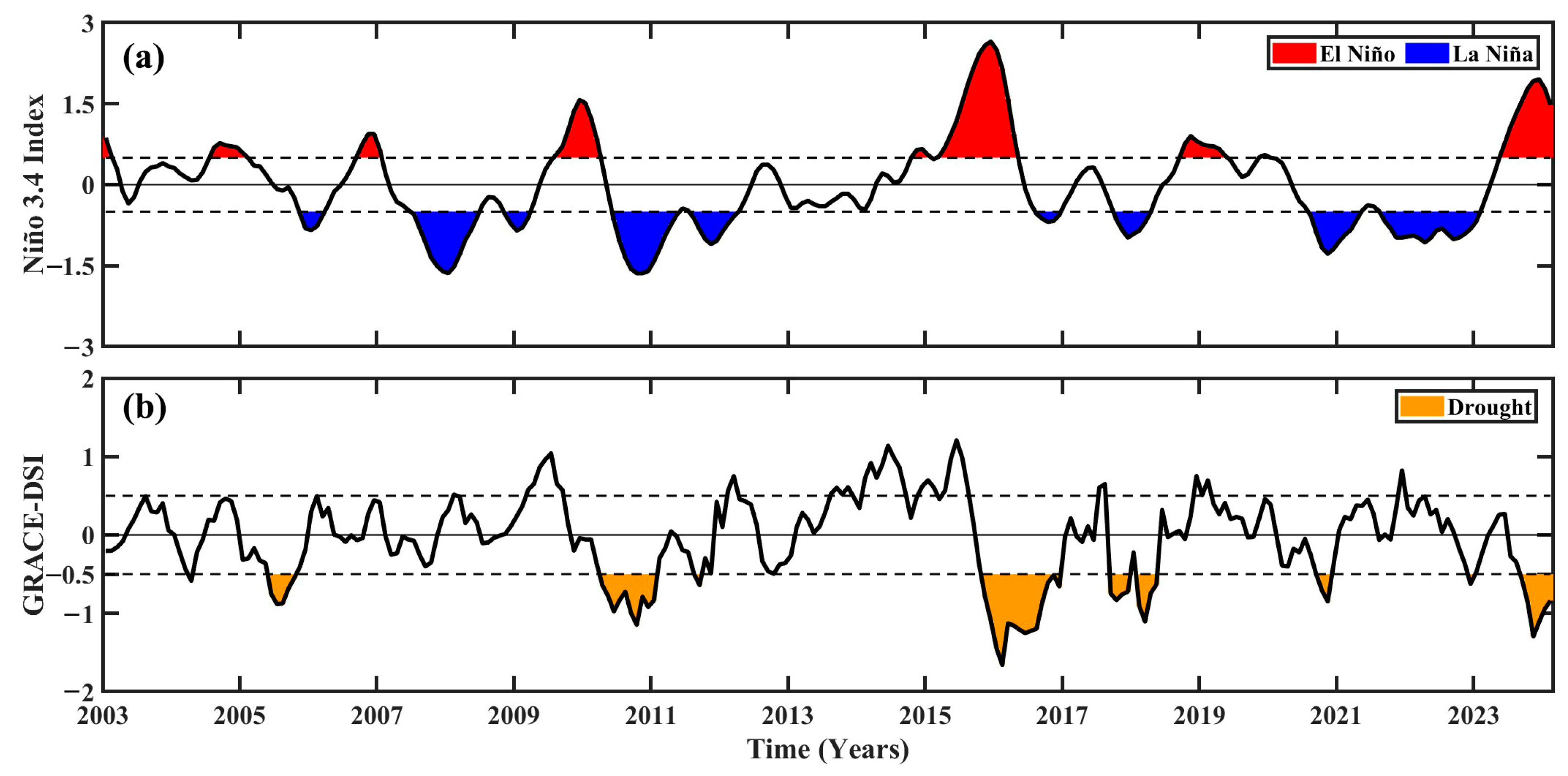
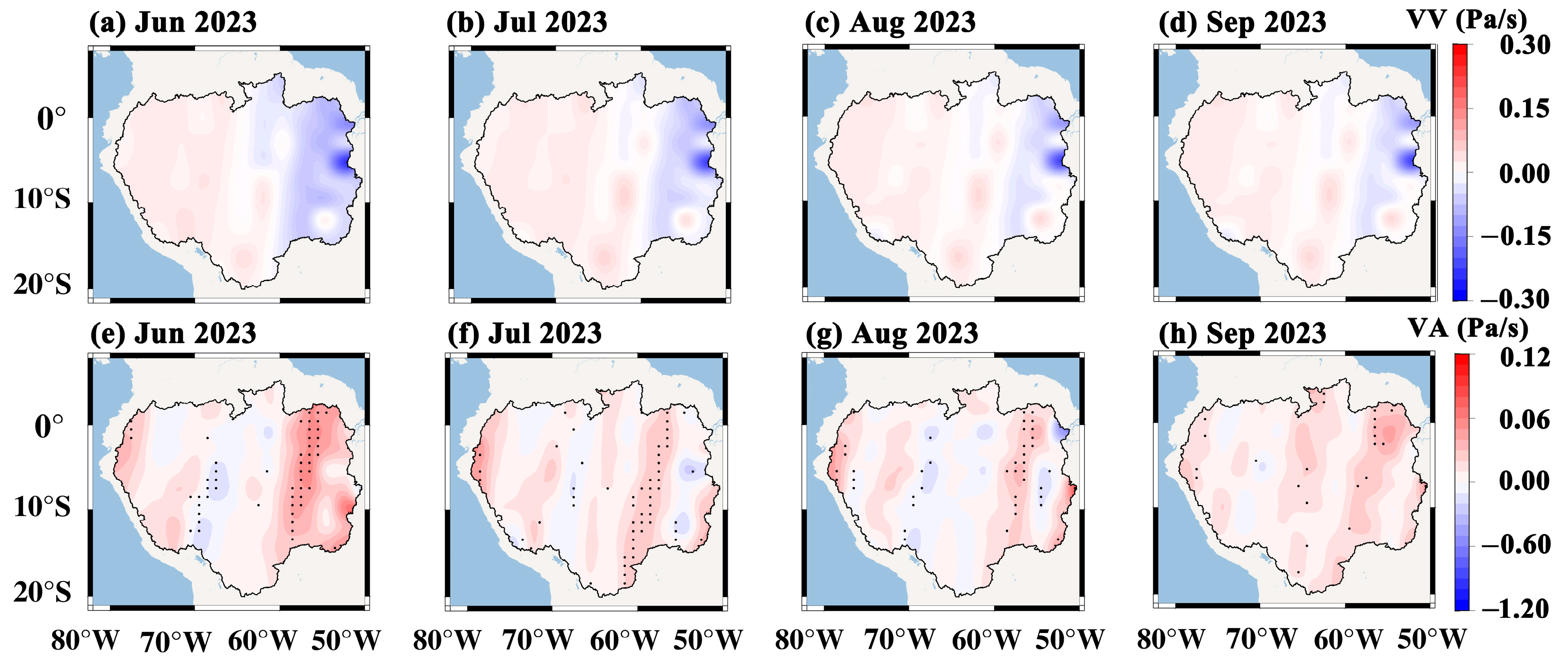
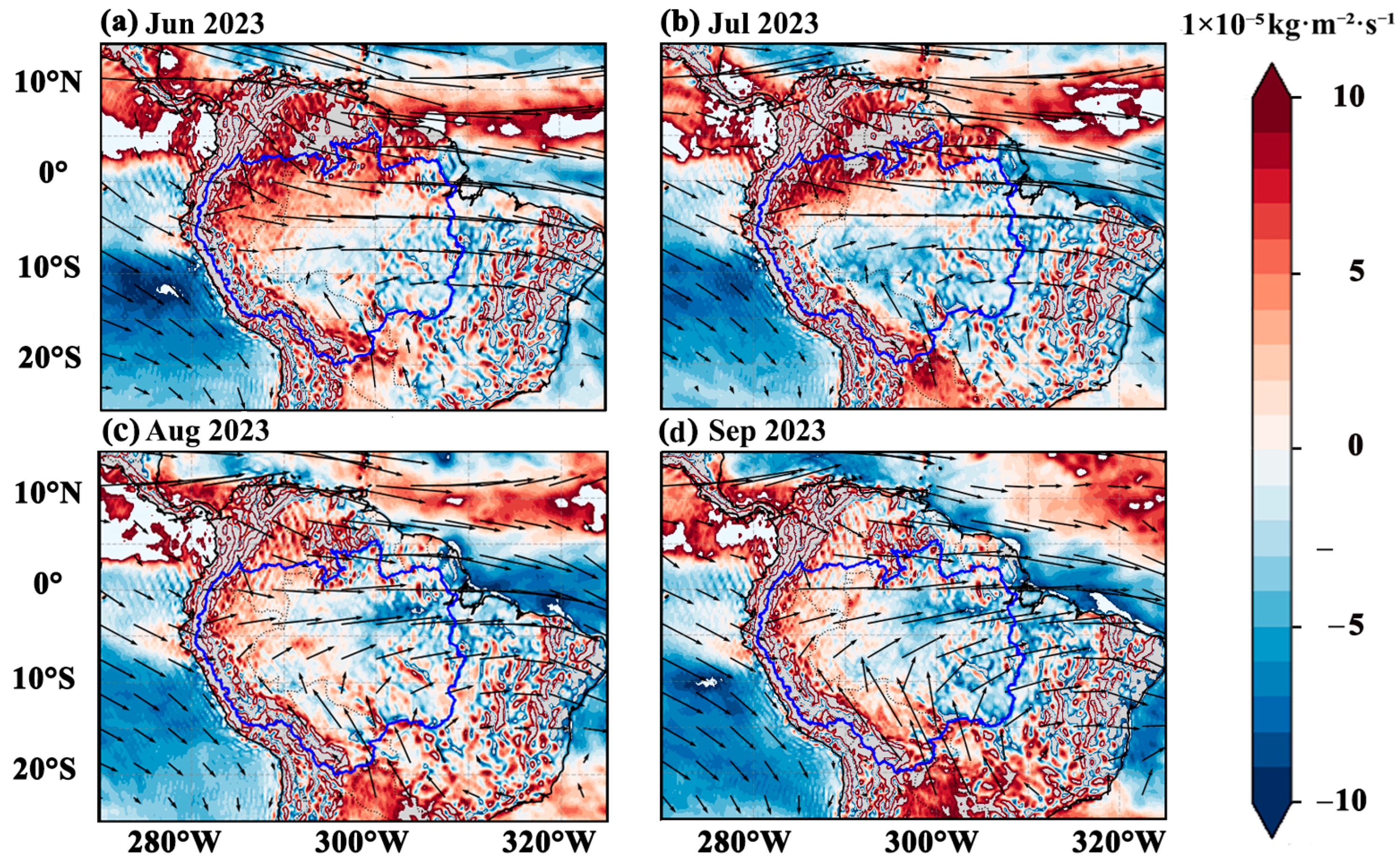
| Variable Name | Data Source | Time Span | Spatial Resolution | Temporal | Data Source |
|---|---|---|---|---|---|
| GRACE/GFO TWSC | CSR | 200301–202402 | 1° × 1° | Monthly | https://icgem.gfz-potsdam.de/sl/temporal, accessed on 25 July 2025 |
| JPL | |||||
| GFZ | |||||
| CSR Mascon | 0.25° × 0.25° | https://www2.csr.utexas.edu/grace/RL05_mascons.html. accessed on 25 July 2025 | |||
| JPL Mascon | 0.5° × 0.5° | https://grace.jpl.nasa.gov/data/get-data/jpl_global_mascons/, accessed on 25 July 2025 | |||
| PRE | GPM | 200301–202402 | 0.1° × 0.1° | Monthly | https://disc.gsfc.nasa.gov/datasets/GPM_3IMERGM_07/summary?keywords=GPM, accessed on 25 July 2025 |
| ET | ERA5-Land | 200301–202402 | 0.1° × 0.1° | Monthly | https://cds.climate.copernicus.eu/datasets/reanalysis-era5-land-monthly-means?tab=overview, accessed on 25 July 2025 |
| SM | |||||
| Surface runoff | |||||
| Subsurface runoff | |||||
| SPEI | - | 2003–2022 | 0.5° × 0.5° | Monthly | https://spei.csic.es/database.html, accessed on 25 July 2025 |
| SCPDSI | - | 2003–2022 | 0.5° × 0.5° | Monthly | https://crudata.uea.ac.uk/cru/data/drought/, accessed on 25 July 2025 |
| CMI | 200301–202402 | 0.5° × 0.5° | Monthly | https://superdrought.com/data.html, accessed on 25 July 2025 | |
| Niño3.4 index | NOAA | 200301–202402 | - | Monthly | https://www.cpc.ncep.noaa.gov/data/indices/, accessed on 25 July 2025 |
| VV | ERA5 | 1994–2024 | 0.5° × 0.5° | Monthly | https://cds.climate.copernicus.eu/datasets/reanalysis-era5-pressure-levels-monthly-means?tab=overview, accessed on 25 July 2025 |
| Specific Humidity | 2003–2024 | ||||
| u-wind | 2003–2024 | ||||
| v-wind | 2003–2024 |
| Category | Description | GRACE-DSI |
|---|---|---|
| D0 | Near normal | GRACE-DSI > −0.5 |
| D1 | Light drought | −0.8 ≤ GRACE-DSI < −0.5 |
| D2 | Moderate drought | −1.3 ≤ GRACE-DSI < −0.8 |
| D3 | Severe drought | −1.6 ≤ GRACE-DSI < −1.3 |
| D4 | Extreme drought | −2.0 ≤ GRACE-DSI < −1.6 |
| D5 | Exceptional drought | GRACE-DSI < −2.0 |
| Description | DAR |
|---|---|
| Territorial drought | DAR ≥ 50% |
| Regional drought | 33% ≤ DAR < 50% |
| Partial regional drought | 25% ≤ DAR < 33% |
| Localized drought | 10% ≤ DAR < 25% |
| Near normal | DAR < 10% |
| Event | Time Span | Duration (Months) | GRACE-DSI | Previous Studies Validation (Y/N) | ||
|---|---|---|---|---|---|---|
| Peak Magnitude | Average Magnitude | Drought Severity | ||||
| 1 | 200506–200510 | 5 | −0.88 | −0.75 | −3.75 | Y [61] |
| 2 | 201004–201101 | 10 | −1.15 | −0.86 | −8.64 | Y [18] |
| 3 | 201511–201612 | 14 | −1.66 | −1.06 | −14.79 | Y [28] |
| 4 | 201709–201805 | 9 | −1.10 | −0.74 | −6.67 | Y [29] |
| 5 | 202009–202011 | 3 | −0.85 | −0.69 | −2.07 | Y [62] |
| 6 | 202309–202402 | 6 | −1.29 | −0.94 | −5.62 | Y |
Disclaimer/Publisher’s Note: The statements, opinions and data contained in all publications are solely those of the individual author(s) and contributor(s) and not of MDPI and/or the editor(s). MDPI and/or the editor(s) disclaim responsibility for any injury to people or property resulting from any ideas, methods, instructions or products referred to in the content. |
© 2025 by the authors. Licensee MDPI, Basel, Switzerland. This article is an open access article distributed under the terms and conditions of the Creative Commons Attribution (CC BY) license (https://creativecommons.org/licenses/by/4.0/).
Share and Cite
Zhou, J.; Cui, L.; Li, Y.; Yao, C.; Meng, J.; Zou, Z.; Lu, Y. GRACE/GFO and Swarm Observation Analysis of the 2023–2024 Extreme Drought in the Amazon River Basin. Remote Sens. 2025, 17, 2765. https://doi.org/10.3390/rs17162765
Zhou J, Cui L, Li Y, Yao C, Meng J, Zou Z, Lu Y. GRACE/GFO and Swarm Observation Analysis of the 2023–2024 Extreme Drought in the Amazon River Basin. Remote Sensing. 2025; 17(16):2765. https://doi.org/10.3390/rs17162765
Chicago/Turabian StyleZhou, Jun, Lilu Cui, Yu Li, Chaolong Yao, Jiacheng Meng, Zhengbo Zou, and Yuheng Lu. 2025. "GRACE/GFO and Swarm Observation Analysis of the 2023–2024 Extreme Drought in the Amazon River Basin" Remote Sensing 17, no. 16: 2765. https://doi.org/10.3390/rs17162765
APA StyleZhou, J., Cui, L., Li, Y., Yao, C., Meng, J., Zou, Z., & Lu, Y. (2025). GRACE/GFO and Swarm Observation Analysis of the 2023–2024 Extreme Drought in the Amazon River Basin. Remote Sensing, 17(16), 2765. https://doi.org/10.3390/rs17162765








